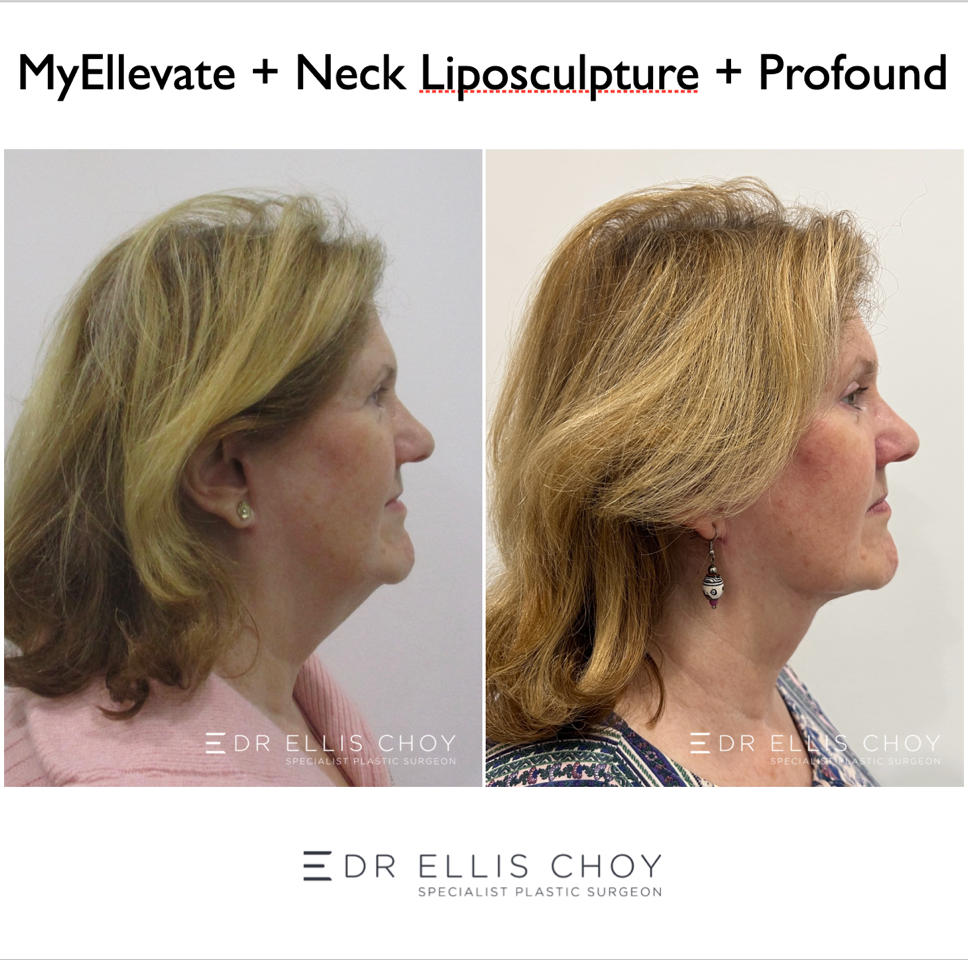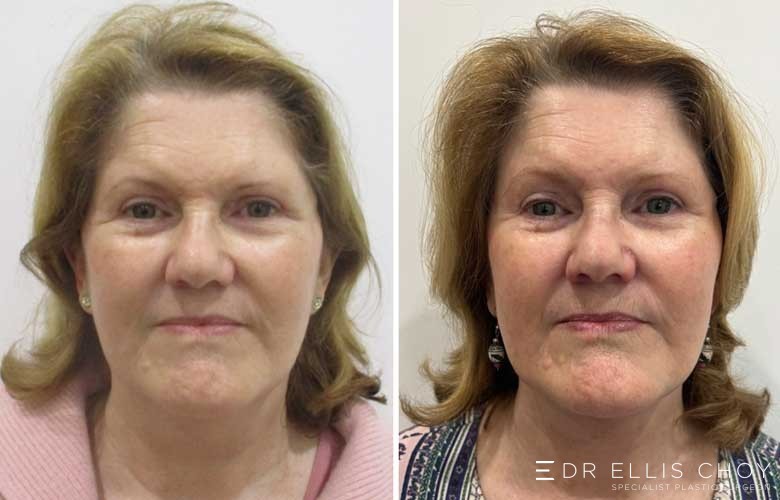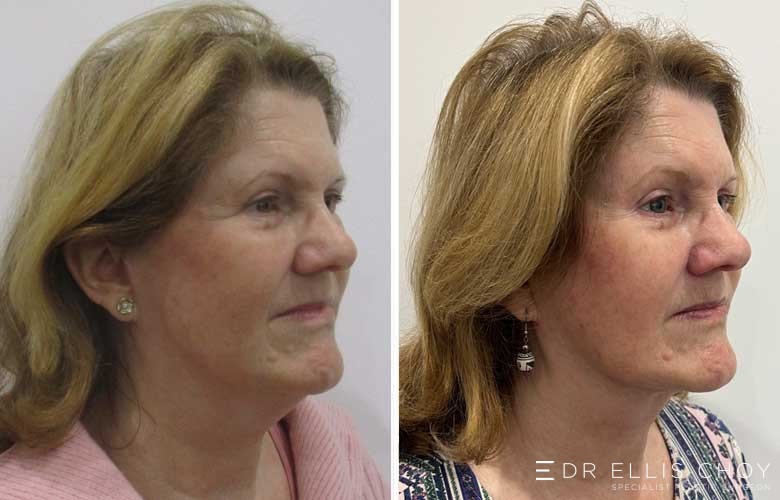MyEllevate With Sydney Plastic Surgeon Dr Ellis Choy
As we age, the skin around our neck loses elasticity and starts to loosen. A neck lift has traditionally been the way to address these changes, but with the introduction of MyEllevate, a less-invasive and lower-downtime option is now available.
The MyEllevate technique was developed by a plastic surgeon in Beverly Hills, CA. Rather than using an invasive open surgical approach, MyEllevate uses sutures that can be placed without incisions to lift and smooth the tissues of the neck.
To book a consultation with Sydney Specialist Plastic Surgeon Dr Ellis Choy, please enquire here. Dr Choy and his team are committed to providing you with the information and personalised attention you need to decide if MyEllevate is right for you.
What Are the Benefits of the MyEllevate Technique?

MyEllevate is designed to lift and tighten the tissues around the neck and jawline in a less invasive manner than neck lift surgery. Dr Choy performs the procedure by using a specialised suture and rod system to create a support structure for loose neck skin, as well as the underlying muscles and glands.
This innovative approach to neck rejuvenation may offer a variety of benefits to an appropriate candidate, including:
- Can be done under local anaesthesia
- No use of linear incisions
- No requirement for drains during recovery
- Reduced risk and wound healing issues compared to open surgery
- Reduced downtime compared to open surgery
- Less visible scarring than a traditional neck lift
- Less likely to produce an unnatural, overly-pulled look
What Signs of Ageing Can MyEllevate Target?
MyEllevate patients can see improvement in some of the most common changes that occur with the ageing process, such as:
- Loss of jawline definition
- Development of jowls
- Loose skin along the neck (“turkey neck”)
- Protruding platysmal bands
- Prominent glands underneath the neckline
Am I a Candidate for MyEllevate?
 Candidates for the MyEllevate procedure tend to fall into one of two broad categories. The first category includes patients who are beginning to show early signs of ageing in their neck and jawline. These patients notice changes like jowls or a “turkey neck”, but their skin laxity is not severe. MyEllevate can address this patient group’s concerns with reduced risk, discomfort and downtime than a full surgical neck lift. However, in cases of more advanced ageing, a traditional neck lift may be a better fit.
Candidates for the MyEllevate procedure tend to fall into one of two broad categories. The first category includes patients who are beginning to show early signs of ageing in their neck and jawline. These patients notice changes like jowls or a “turkey neck”, but their skin laxity is not severe. MyEllevate can address this patient group’s concerns with reduced risk, discomfort and downtime than a full surgical neck lift. However, in cases of more advanced ageing, a traditional neck lift may be a better fit.
The second category includes patients who are not yet noticeably affected by the ageing process, but who naturally lack jawline definition or have a degree of neck fullness. These patients tend to be younger and still have tight, elastic skin. For such patients, MyEllevate may be an option for neck and jawline contouring.
For any surgical procedure, you should be healthy, maintain a stable weight, be a non-smoker and be fully educated about the operation and anticipated results. Dr Choy will assess your candidacy for MyEllevate during a consultation and offer guidance so you can make informed choices about your cosmetic care.
MyEllevate vs. Neck Lift Surgery
A surgical neck lift is an invasive procedure performed under general anaesthesia. The incision typically begins in the hairline around the level of the sideburn, then continues down and around the ear, and ends at the back of the head. There may also be an incision under the chin.
Through these incisions, the surgeon can reposition the underlying tissue, tighten the platysma muscle and redistribute fat. The surgeon then redrapes the skin over the adjusted contours and removes any excess skin.
There are pros and cons to choosing this approach. Because it is more invasive than MyEllevate, it gives the surgeon more access to the structures of the neck, and therefore more ability to make adjustments. This can be advantageous for patients who are farther into the ageing process and seeking a more significant degree of change.
The drawbacks of a more invasive procedure are increased risk, more discomfort and a longer recovery period with more restrictions. A surgical neck lift also requires general anaesthesia and leaves behind longer scars.
There is no one approach that is right for everyone. Dr Choy will explain your options in detail and help you choose a technique that is suitable for your needs and goals.
What Is Involved in the MyEllevate Procedure?
During the MyEllevate procedure, Dr Choy uses an illuminated rod to weave a suture underneath the skin and create a suspension system. The suture is threaded through the underlying tissues such that, when Dr Choy pulls it, it cinches in a manner similar to lacing a shoe or a corset. This elevates the soft tissues and holds them in place, creating a more defined jawline and neck contour.
The MyEllevate procedure is performed through punctures rather than incisions. These small entry points require no sutures and leave less perceptible scarring. The procedure is typically completed within one hour.
What Risks Should I Be Aware Of?
Although MyEllevate is less invasive than a traditional neck lift procedure, no surgery is without risk. The risks include bleeding, infection, scarring, asymmetry and persistent inflammation around the suture. In the event that infection or prolonged swelling occurs and cannot be resolved, the suture may need to be removed.
Every patient is different and may have unique risks associated with their specific case. During your consultation, Dr Choy will discuss potential risks and complications in detail before you make a decision about the procedure.
If the risk profile of a surgical procedure is not acceptable to you, nonsurgical treatments such as Ulthera, Thermage, Accent Prime, Profound or Secret RF microneedling may be options.
What Should I Expect During Recovery?
You may experience some discomfort, swelling, tightness and numbness following the MyEllevate procedure. Many patients return to work within a few days if there is no significant bruising or swelling. If bruising and swelling do occur, they can last for up to two weeks, and you may prefer to delay your return to the public eye until after they subside.
Strenuous physical activities, including exercise, should be suspended for 10 to 14 days to avoid straining your neck or elevating your blood pressure. You must temporarily wear a neck collar or chin strap to assist the healing process.
What Results Can Be Achieved With MyEllevate?
 MyEllevate instantly lifts the tissues of the neck and jawline when the suture suspension system is tightened. While the degree of improvement and duration of results are individually variable, most patients can expect to see enhanced jawline definition as well as improvements in neck contour and fullness. Maintaining a healthy lifestyle and taking care of your skin are vital for extending the longevity of your results.
MyEllevate instantly lifts the tissues of the neck and jawline when the suture suspension system is tightened. While the degree of improvement and duration of results are individually variable, most patients can expect to see enhanced jawline definition as well as improvements in neck contour and fullness. Maintaining a healthy lifestyle and taking care of your skin are vital for extending the longevity of your results.
Request More Information About MyEllevate With Dr Ellis Choy
The demand for less invasive aesthetic procedures has led to innovative developments in skin tightening and facial rejuvenation, including MyEllevate. Dr Choy is excited to bring MyEllevate to Sydney for patients seeking an alternative to traditional neck lift surgery.
Contact the Sydney offices of Dr Ellis Choy to learn more. You may reach us on 02 8962 9388 or enquire here to book a consultation.
Making an Informed Decision
Undergoing plastic surgery is a significant decision that should be made only after careful consideration of all aspects involved, including the potential risks and complications.
General Risks and Complications
There are general risks and complications that apply to most plastic surgery procedures. These are discussed in detail on our Risks and Complications page.
Specific Risks and Complications
In addition to those that apply generally to plastic surgery, each individual procedure comes with its own specific risks and complications. For MyEllevate, these include:
- Persistent inflammation around the suture
- Dimpling
- Asymmetrical results
- Chronic foreign body sensation
- Facial weakness
Next Steps
Request a consultation with Dr Choy for a detailed discussion of these considerations. Dr Choy will conduct a thorough risk assessment based on your individual factors and outline the measures that can be taken to minimise these risks. He and his team are here to support your decision-making process, providing all the information you need to make well-informed choices about your care.